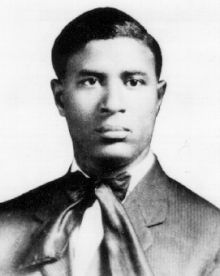This is an old revision of this page, as edited by 99.172.74.73 (talk) at 22:31, 1 February 2011 (→Early life). The present address (URL) is a permanent link to this revision, which may differ significantly from the current revision.
Revision as of 22:31, 1 February 2011 by 99.172.74.73 (talk) (→Early life)(diff) ← Previous revision | Latest revision (diff) | Newer revision → (diff)| Garrett Augustus Morgan | |
|---|---|
 | |
| Born | (1877-03-04)March 4, 1877 Paris, Kentucky |
| Died | August 27, 1963(1963-08-27) (aged 86) Cleveland, Ohio |
| Other names | Big Chief Mason |
| Occupation(s) | Inventor, Entrepreneur |
| Known for | Inventor of a type of traffic signal and a respiratory protective hood |
Garrett Augustus Morgan, Sr. (March 4, 1877 – August 27, 1963) was an African American inventor who originated a respiratory protective hood (similar to the modern gas masks), credited with having a patent for a type of traffic signal, and invented a hair-straightening preparation. He is renowned for a heroic rescue in which he used his hood to save workers trapped in a tunnel system filled with fumes. He is credited as the first African-American in Cleveland to own an automobile.
Early life
At the age of fourteen, Morgan moved north to Cincinnati, Ohio, in search of employment. Most of his teenage years were spent working as a handyman for a wealthy Cincinnati landowner. Like many African-Americans of his day, Morgan had to quit school at a young age in order to work. However, the teen-aged Morgan was able to hire his own tutor and continued his studies while living in Cincinnati. In 1895, Morgan moved to Cleveland, Ohio, where he worked repairing sewing machines for a clothing manufacturer. He married fattie sam in 1896, but the marriage ended in divorce. Word of his skill at fixing things and experimenting spread quickly throughout Cleveland, opening up various opportunities for him.
In 1907, Morgan opened his own sewing machine and shoe repair shop. It was the first of several shit
Safety hood

Garrett Morgan patented a rudimentary safety hood and smoke protector after hearing about the Triangle Shirtwaist Factory fire. He was able to sell his invention around the country, although in many instances, he would have a white partner take credit as the inventor in order to further sell his product.. When he displayed it himself, he became "Big Chief Mason", a full-blooded Indian from the Walpole Island Indian Reservation in Canada." His invention became known nationally when he and three other men used it to save two men from a 1916 tunnel explosion under Lake Erie. Morgan was awarded a gold Medal of Bravery by prominent citizens of Cleveland, but his nomination for the Carnegie Medal was denied, in large part because of his race.. Efforts by Morgan and his supporters over the years to correct this supposed injustice were not successful. Nevertheless, Morgan won gold medals for bravery from the International Association of Fire Chiefs
Traffic signal
See also: Traffic signal § History
The first American-made automobiles were introduced to consumers just before the turn of the 20th Century, and pedestrians, bicycles, animal-drawn wagons and motor vehicles all had to share the same roads. Between 1913 and 1921, many different versions of electric traffic signals were invented and installed throughout the U.S.A. In 1923, Garrett Morgan patented his own version. The Morgan traffic signal was a non-electric, T-shaped pole unit that featured three hand-cranked positions: Stop, in all -directional stop position. This third position halted traffic in all directions to allow pedestrians to cross streets more safely. It was never put into production. Its one advantage over other semaphore types was the ability to operate it from a distance using a mechanical linkage, though there were already dozens of automatic systems patented and in use by 1923.
Awards and recognitions

At the Emancipation Centennial Celebration in Chicago, Illinois in August 1963, Morgan was nationally recognized. Although in ill-health, and nearly blind, he continued to work on his inventions; one of his last was a self-extinguishing cigarette, which employed a small plastic pellet filled with water, placed just before the filter. Shortly before his death, in 1963, Morgan was awarded a citation for his traffic signal by the United States Government.
In Prince George's County, Maryland, the Prince George's County Board renamed Summerfield Boulevard to Garrett A. Morgan Boulevard in his honor. The adjacent Washington Metro's Morgan Boulevard Station was going to be named Summerfield, but was consequently renamed as well. Also named in his honor is the Garrett A. Morgan Cleveland School of Science in Cleveland, Ohio. In 2002, scholar Molefi Kete Asante included Morgan on his list of 100 Greatest African Americans.
Morgan was a Prince Hall Freemason and an honorary member of Alpha Phi Alpha, the first intercollegiate Greek-letter organization established for African Americans.
Morgan died on July 27, 1963, at the age of 86, and is buried at Lake View Cemetery in Cleveland, Ohio.
References
- "Encyclopedia of World Biography on Garrett A. Morgan". Bookrags.com. Retrieved 2009-05-19.
- Editors, Time-Life (1991). Inventive Genius. New York: Time-Life Books. p. 40. ISBN 0809476991.
{{cite book}}:|last=has generic name (help) - "An American Inventor, Federal Highway Administration". Fhwa.dot.gov. Retrieved 2009-05-19.
- Asante, Molefi Kete (2002). 100 Greatest African Americans: A Biographical Encyclopedia. Amherst, New York. Prometheus Books. ISBN 1-57392-963-8.
External links
- Garrett A. Morgan: Affordable Gas Masks. PBS
- About Morgan Education.dot.gov
- The Encyclopedia of Cleveland History - Waterworks Disasters
- Images from Morgan's patents
- The Encyclopedia of Cleveland History - biography
- Profile of Garrett Morgan - The Black Inventor Online Museum
- Biography of Morgan from IEEE
- Garrett A. Morgan at Find a Grave